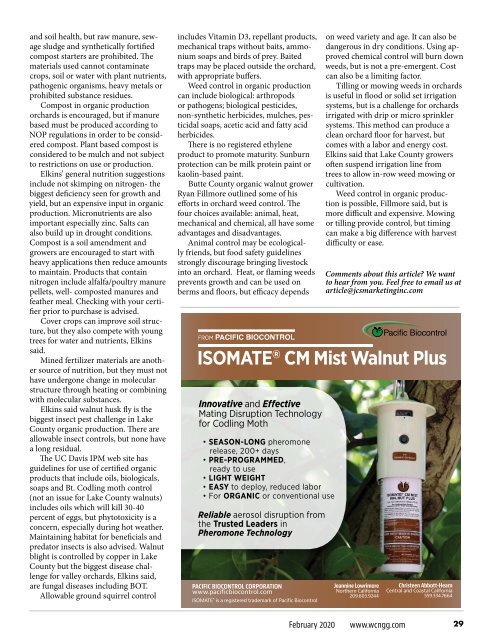You also want an ePaper? Increase the reach of your titles
YUMPU automatically turns print PDFs into web optimized ePapers that Google loves.
and soil health, but raw manure, sewage<br />
sludge and synthetically fortified<br />
compost starters are prohibited. The<br />
materials used cannot contaminate<br />
crops, soil or water with plant nutrients,<br />
pathogenic organisms, heavy metals or<br />
prohibited substance residues.<br />
Compost in organic production<br />
orchards is encouraged, but if manure<br />
based must be produced according to<br />
NOP regulations in order to be considered<br />
compost. Plant based compost is<br />
considered to be mulch and not subject<br />
to restrictions on use or production.<br />
Elkins’ general nutrition suggestions<br />
include not skimping on nitrogen- the<br />
biggest deficiency seen for growth and<br />
yield, but an expensive input in organic<br />
production. Micronutrients are also<br />
important especially zinc. Salts can<br />
also build up in drought conditions.<br />
Compost is a soil amendment and<br />
growers are encouraged to start with<br />
heavy applications then reduce amounts<br />
to maintain. Products that contain<br />
nitrogen include alfalfa/poultry manure<br />
pellets, well- composted manures and<br />
feather meal. Checking with your certifier<br />
prior to purchase is advised.<br />
Cover crops can improve soil structure,<br />
but they also compete with young<br />
trees for water and nutrients, Elkins<br />
said.<br />
Mined fertilizer materials are another<br />
source of nutrition, but they must not<br />
have undergone change in molecular<br />
structure through heating or combining<br />
with molecular substances.<br />
Elkins said walnut husk fly is the<br />
biggest insect pest challenge in Lake<br />
County organic production. There are<br />
allowable insect controls, but none have<br />
a long residual.<br />
The UC Davis IPM web site has<br />
guidelines for use of certified organic<br />
products that include oils, biologicals,<br />
soaps and Bt. Codling moth control<br />
(not an issue for Lake County walnuts)<br />
includes oils which will kill 30-40<br />
percent of eggs, but phytotoxicity is a<br />
concern, especially during hot weather.<br />
Maintaining habitat for beneficials and<br />
predator insects is also advised. Walnut<br />
blight is controlled by copper in Lake<br />
County but the biggest disease challenge<br />
for valley orchards, Elkins said,<br />
are fungal diseases including BOT.<br />
Allowable ground squirrel control<br />
includes Vitamin D3, repellant products,<br />
mechanical traps without baits, ammonium<br />
soaps and birds of prey. Baited<br />
traps may be placed outside the orchard,<br />
with appropriate buffers.<br />
Weed control in organic production<br />
can include biological: arthropods<br />
or pathogens; biological pesticides,<br />
non-synthetic herbicides, mulches, pesticidal<br />
soaps, acetic acid and fatty acid<br />
herbicides.<br />
There is no registered ethylene<br />
product to promote maturity. Sunburn<br />
protection can be milk protein paint or<br />
kaolin-based paint.<br />
Butte County organic walnut grower<br />
Ryan Fillmore outlined some of his<br />
efforts in orchard weed control. The<br />
four choices available: animal, heat,<br />
mechanical and chemical, all have some<br />
advantages and disadvantages.<br />
Animal control may be ecologically<br />
friends, but food safety guidelines<br />
strongly discourage bringing livestock<br />
into an orchard. Heat, or flaming weeds<br />
prevents growth and can be used on<br />
berms and floors, but efficacy depends<br />
Innovative and Effective<br />
Mating Disruption Technology<br />
for Codling Moth<br />
• SEASON-LONG pheromone<br />
release, 200+ days<br />
• PRE-PROGRAMMED,<br />
ready to use<br />
• LIGHT WEIGHT<br />
• EASY to deploy, reduced labor<br />
• For ORGANIC or conventional use<br />
Reliable aerosol disruption from<br />
the Trusted Leaders in<br />
Pheromone Technology<br />
PACIFIC BIOCONTROL CORPORATION<br />
www.pacificbiocontrol.com<br />
ISOMATE ® is a registered trademark of Pacific Biocontrol<br />
on weed variety and age. It can also be<br />
dangerous in dry conditions. Using approved<br />
chemical control will burn down<br />
weeds, but is not a pre-emergent. Cost<br />
can also be a limiting factor.<br />
Tilling or mowing weeds in orchards<br />
is useful in flood or solid set irrigation<br />
systems, but is a challenge for orchards<br />
irrigated with drip or micro sprinkler<br />
systems. This method can produce a<br />
clean orchard floor for harvest, but<br />
comes with a labor and energy cost.<br />
Elkins said that Lake County growers<br />
often suspend irrigation line from<br />
trees to allow in-row weed mowing or<br />
cultivation.<br />
Weed control in organic production<br />
is possible, Fillmore said, but is<br />
more difficult and expensive. Mowing<br />
or tilling provide control, but timing<br />
can make a big difference with harvest<br />
difficulty or ease.<br />
Comments about this article? We want<br />
to hear from you. Feel free to email us at<br />
article@jcsmarketinginc.com<br />
ISOMATE ® CM Mist Walnut Plus<br />
Jeannine Lowrimore<br />
Northern California<br />
209.603.9244<br />
Christeen Abbott-Hearn<br />
Central and Coastal California<br />
559.334.7664<br />
<strong>February</strong> <strong>2020</strong><br />
www.wcngg.com<br />
29


















